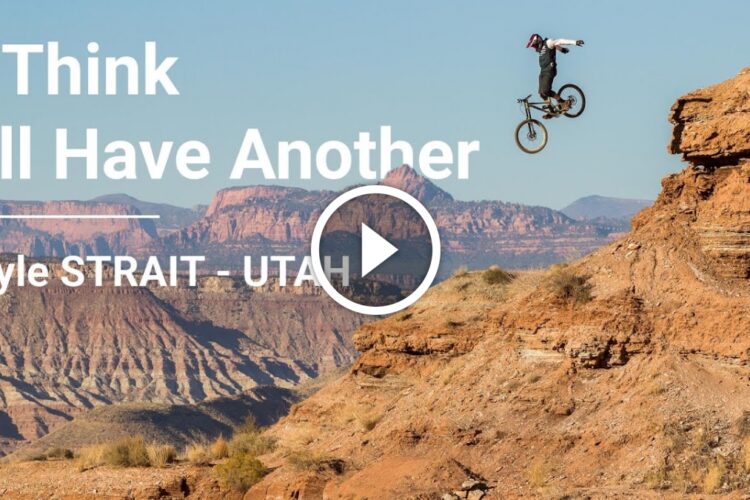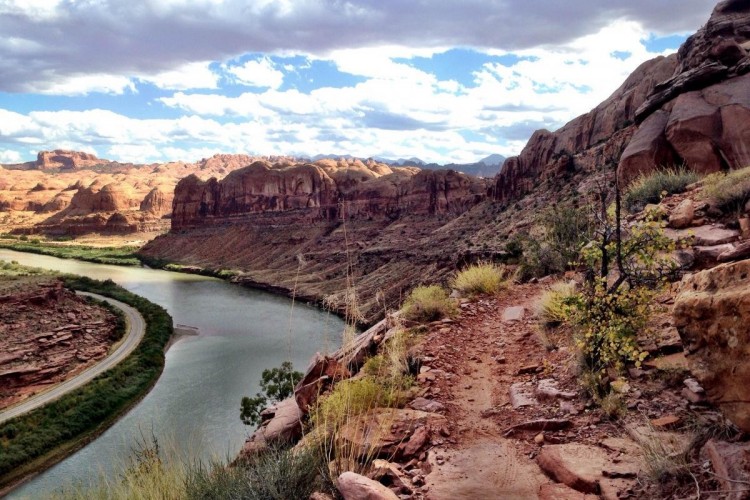
If you’re new to Phoenix you might be surprised at not only the number of mountain bike trails spread throughout the metro area’s many parks and reserves but by the quality and variety as well. That’s right, not all of the trails are full-face-helmeted, body-armored, technical drop fests (like South Mountain’s National Trail). There are also miles upon miles of beginner-friendly trails for those who are more cross-country minded and downhill averse. That said, don’t scratch these off your list of rides if you are at an intermediate or advanced skill level. All of these trails become something altogether different when you ride them with speed and reckless abandon. Each has side trails and spurs branching off from them that are more difficult if you should so choose to sample those.
A few caveats before we begin: Phoenix gets hot from May to early October. Very hot. Every summer someone dies on the trails who hikes or bikes in extreme heat when they shouldn’t have. Ride early, drink a lot, and be careful out there.
OK, time to hit the trails.
Usery Mountain Regional Park

This is by far the flattest and easiest of the five trails included in this list, and a perfect place to take someone riding for the first time. Located just outside of the Phoenix suburb of Mesa, it doesn’t tend to get as crowded as the popular Phoenix trails. The trails are either slightly uphill or down, and for the most part, rather straight as they meanders gently down through several desert washes on smooth, sandy single and doubletrack.
The 3-mile Blevins Loop is the center of the trail system, but add in the curvy Moon Rock Trail or shred through the more rocky Meridian/County Line/Ruidoso Trails combo, and the miles start to fly by. To add some spice, go up and over Cat’s Peak a couple times, which is the only real intermediate, hilly, somewhat technical area of the park, and take a look at the desert landscape, which is filled with saguaro, cholla, and prickly pear cacti as far as you can see. Along the way you may see some coyotes, jackrabbits, roadrunners, lizards, quails, and on rare occasions, javelina, rattlesnakes, and even deer.
From this point, Pass Mountain is directly to the north of the park, and 10 miles to the east you have a clear view of the impressive Superstition Mountains in the distance (Pass Mountain technically isn’t part of Usery Mountain Regional Park but instead is part of Tonto National Forest).

The beauty of this park for beginners is that you are never far from where you start, and if you get tired, you can usually return to your car rather easily. Just avoid going down any trails with “wash” in their title.
If you want to make things much more challenging, hop on the Pass Mountain Trail in the Tonto National Forest and go north from the park four miles on the west side of Pass Mountain. This is an intermediate level trail for sure, in both terrain and elevation gain, and takes riders to an incredible vista point on the very north side of the mountain’s base. Don’t be seduced by the power of the east side of Pass Mountain, however, and turn around and go back the way you came once you’ve taken in the scenery. The east side offers stunning vistas too but is an absolute rocky mess and a downright dangerous trail unless you have the right bike and advanced skills.

The cost to enter any of the Maricopa County Regional Parks is $7 whether you park at a trailhead or drive in. Pro tip: Entering by bike is only $2, so save $5 by parking nearby and riding in.
San Tan Mountain Regional Park
Another Maricopa County Regional Park, this is just south of the town of Queen Creek, southeast of Phoenix. Though it is quite a sustained climb, the best way to start your ride is to enter at the park’s northernmost trailhead at the end of Wagon Wheel Road, and commence a 1.3 mile gradual ascent on Dynamite Trail, to a saddle, which drops after a series of switchbacks to the San Tan Trail below. The San Tan Trail, when combined with Littleleaf and a portion of Goldmine, is a 7.5 mile loop that runs around a small valley, up and over a mixture of singletrack, doubletrack, and even a wide fire road.

San Tan Trail offers a mix of shreddable features: very fast, long, downhill portions; quick dips through washes; and prolonged climbs up, over, and through big rock outcroppings and cacti. Rarely flat, riders are either going up or down, as a good mountain bike trail should. Though not particularly rocky or uneven, much of the trail is far from buff singletrack.
Riders can traverse the loop one way, and then do it again from the opposite direction for a completely different trail feel. In the middle of San Tan loop are two trails that bisect it, Moonlight and Hedgehog, which add even more variety. Moonlight is mostly downhill going west to east while Hedgehog requires a chug to the top before a screaming burn down from either direction. Stargazer is a fun, winding detour too.

The icing on top of this mountain biking cake is reaching the Dynamite saddle on your way back north, as the entire 1.3 miles back to your car is 95 percent downhill, and 100 percent fun.
Like all the Maricopa County Park regional parks, San Tan has exceptionally clean bathrooms with flushing toilets, drinking fountains, and a nature center.
South Mountain – Desert Classic

To call this a “beginner” trail is a bit of a misnomer. Sure, you never gain a lot of elevation or experience a ton of tech if you stay on Desert Class proper, but it is also rocky, fast, and full of deep plunges in and out of loose washes. The trail is far from short, at nearly 18 miles if you go to the end of the almost 9-mile trail, turn around, and come back. As my friend John likes to say, “It’s non-technical, but it’s not a beginner trail either.” A flow trail it is not.
Stretched out like a long snake in the desert sun, Desert Classic is on the south side of South Mountain and runs parallel to the range at its base. The Pima Canyon Trailhead was recently revamped and is a good place to start as it offers free parking.
What Desert Classic lacks in beauty (it is downright ugly, brown, and barren compared to the greenery of Usery, for instance) it makes up for in its rugged “Human vs. Mountain” persona. This trail taunts you, teases you, and begs you to hammer through it before this deceptive serpent strangles you aerobically and leaves you breathless. Beginner trail? Ride it and see.

Some landmarks to ponder: Going west from Pima Canyon Trailhead, you reach a large tan water tank at 3.5 miles, a big boulder outcropping known as “Bus Stop” 6 miles, and a relatively high plateau at 7.25 miles. Unfortunately, those who never go west of the Bus Stop to the saddle miss out as this roughly 1-mile western gem-of-a-segment includes a long rock garden, some brief but techy climbs, and multiple S-curves that take you up to the top.

Like all good trails, Desert Classic has an obligatory offshoot called Goat Trail (skip it) and Secret Trail (ride it), not to mention a 275-foot ascent in less than one mile called Helipad Trail that is certainly not “beginner” but worth the trip if you are up for it.
Despite claiming to be the largest city park in the United States, South Mountain Park, and especially Desert Classic trail, are very crowded on weekends and holiday mornings. Your best bet is to ride at off-peak times if you can and to bring a bell. Otherwise, you’ll be saying “On Your Left” more times than Bernie Sanders at a Trump Rally. That said, for whatever reason Arizona hikers and mountain bikers are usually a pretty laid back, courteous sort, and trail conflict is quite rare. This is possibly because they all left the Midwest’s snow behind when they moved here, and are just plain happy.
Phoenix Mountain Preserve – Trail 100

Beginning at the Dreamy Draw parking lot and trailhead, most people who ride Trail 100 go east and ramble up a gradual 1-mile climb to a saddle. Smack dab in the middle of urban north Phoenix, and just off the often congested Highway 51, it is remarkable how quickly the sights and sounds of the city disappear behind you as you descend from the saddle into the expansive desert valley below.
Even though Trail 100 only goes three miles east from here before terminating at Tatum Boulevard, it is the numerous connector trails that branch from it for miles and miles along the way, both north and south, that make this an explorer’s dream. Some of the connectors (such as Trails 1A and 8) go up higher into the mountains and get increasingly difficult with switchbacks and small drops, while many of the trails to the north retain the fast and flat sand-over-hard dirt nature of 100 itself. If you are looking for something more challenging, check out the more technical and advanced offshoots higher in the mountains, such as Hairball, Cheesegrater, and Voaz.

While most people prefer Trail 100’s east side, if you have time on another day you may want to go west of the Dreamy Draw parking lot and sample Trail 100’s west side too, which continues roughly seven miles in a northwest direction. You access it by going under freeway 51 through a tunnel. Other than a few steep climbs and descents in the first couple miles, the west side is rather tame thereafter.
McDowell Mountain Regional Park – Sport Loop

North of the town of Fountain Hills lies McDowell Mountain Regional Park and over 50 miles of mountain biking trails. While most of these trails are rated beginner and intermediate, the part you will likely want to check out first is the Competitive Track, which includes three racing courses: Sport Loop, Tech Loop, and Long Loop. Totaling almost 14 miles of single-direction riding, Sport Loop has the most beginner appeal. Just three miles in length, you gradually pedal up this trail for about 1.5 miles before grinning your way back down through several fast, straight sections with occasional dips, twists, and turns, to include a few half-pipe-like cambered corners toward the very end.
Since the trail surface is so incredibly buff and the layout so well crafted, Sport Loop allows beginners to challenge themselves with speed and cornering in a way that is both safe and rare when compared to your typical rocky desert singletrack. Like a catchy hip-hop song, it’s so fun and short you just may want to repeat it again and again.

For history lovers, the Competitive Track is also the home of the Specialized Cactus Cup, which in the late 90s saw the likes of Ned Overend, John Tomac, Dave Weins, and Juli Furtado tearing up the dirt. The trail was hand-cut by inmates.
While Long Loop and Tech Loop may be too much for a novice, in 2013 the park built the Escondido Trail just north of the Competitive Track that an aerobically-fit beginner would find challenging, yet doable. An out-and-back trail that is almost 13 miles in length, the first three miles serves up a series of very fast straight downhills on hard, smooth, marble-like singletrack, that alternates with long, gradual ascents, a few sharp corners, and even a bit of exposure. The last two miles before the turn-around point rises about 250 feet in elevation, so riders will certainly earn their views at the top.
Other Phoenix beginner trails to consider:
- Papago Park, Tempe
- Brown’s Ranch, Scottsdale
- Estrella Mountain Regional Park, Goodyear
- Fantasy Island North Singletrack (FINS), Goodyear
- White Tank Mountain Regional Park, Surprise
What is your go-to trail for taking first time riders in Phoenix?





















6 Comments
Apr 25, 2019
Apr 26, 2019
Apr 26, 2019
Apr 26, 2019
Apr 29, 2019
Apr 27, 2019